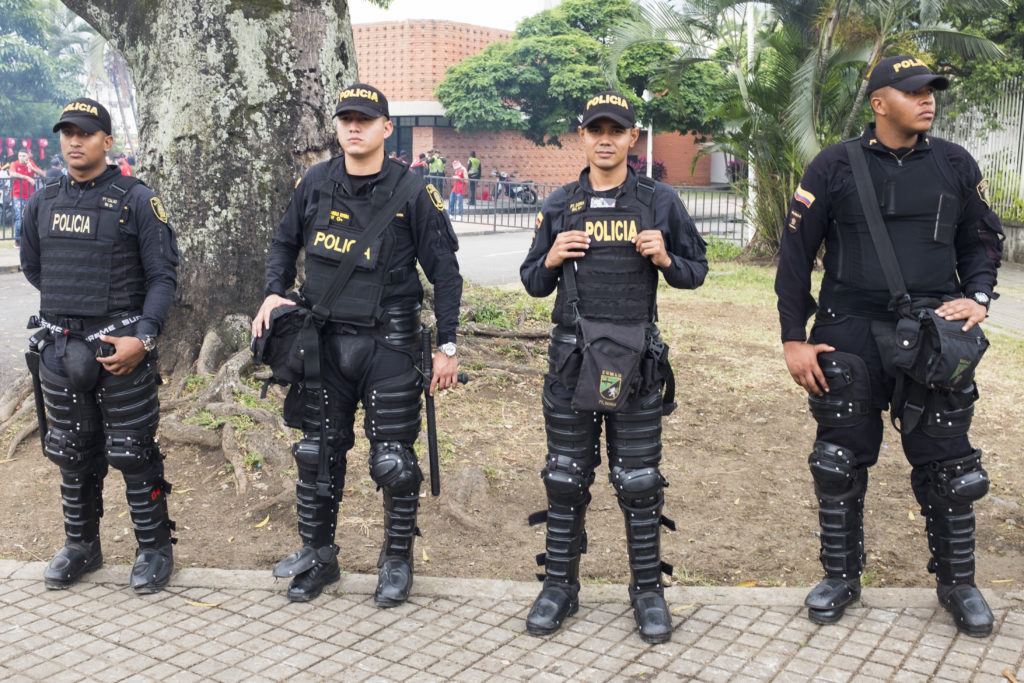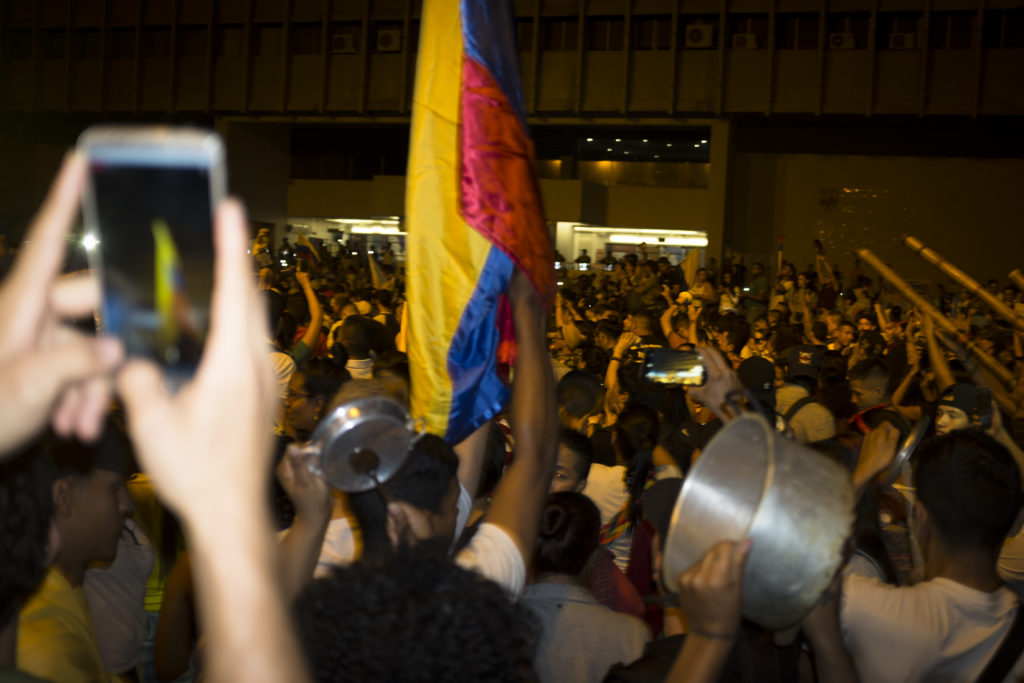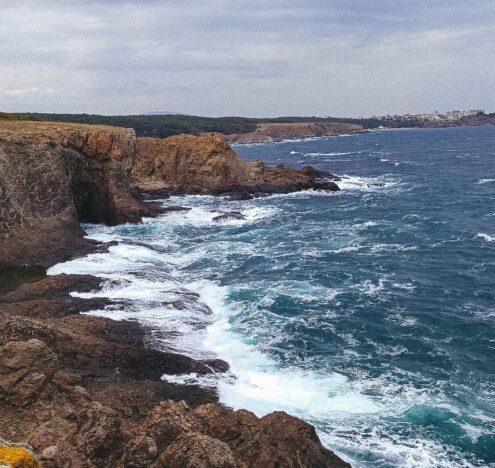This piece is the second chapter of a two part series. You can read the first chapter here.
In Cali, as in every city throughout Latin America, physical violence is exacerbated, if not caused, by economic violence. Social exclusion and poverty are generally considered the biggest indicators of and contributors to violence. Official figures state that upwards of 85% of the Cali’s inhabitants belong to the lowest class, with half of all people between 15 and 24 living in poverty.
Cali is a city deeply divided between the formal economy and the informal economy, between “decent” citizens and the criminal element, between white and Black, and between rich and poor. This division is represented within the geography of the city itself. The western part of the city, nestled below the foothills of the Andes, covered with lush green vegetation and fed by several mountain rivers, is where the city was first founded and it is where the oldest and wealthiest families live. The land in and around Cali, including the sugar plantations that represent much of the wealth of the city, remains in the hands of the descendants of a handful of European families, most from the western part of the city.
The eastern part of the city, on the other hand, is set deep within a dry, barren valley, far from the cooling breeze that comes down from the mountains during sunset. It was first settled in the 1980s by displaced families of indigenous, Afro-Colombian, and mestizo people who came to Cali fleeing violence in the countryside and the coast. Due to poverty and lack of government services, urban violence soon consumed this part of the city and criminal gangs now dominate life in the area.
Extreme social divisions within a city are fault lines waiting to erupt during moments of political tension. The first week of 2019’s protests brought many destructive forces to the surface and exacerbated the preexisting divisions within Cali. Although the media tends to portray the eastern part of the city as the producer of the greatest percentage of crime and violence in the city, it is actually the lowest classes there that are the ones most exposed to violence of all kinds, especially economic violence.
DEMANDING RESPECT
Walking away from the protests on the third day, I went to have lunch at the Galería Alameda, one of the city’s food markets, located just a few blocks from my home. Outside the formal market structure, which occupies a whole square block, there were dozens of informal fruit and vegetable vendors. Among these vendors, several Afro-Colombian women sold avocados on small, flimsy tables.
As I walked by, one of these avocado vendors, a large woman in her 40s, was wrestling with a man in a motorcycle helmet, shaking him from side to side and whacking him upside his helmet. The man stepped back from the woman, got onto his motorcycle, said that he’d be back tomorrow, and drove away. As a tense crowd watched in silence, the woman, crying with rage, yelled after him, “I deserve respect, I deserve respect.”
What might seem like an isolated event was actually a very common scene. Many of the people who set up their business selling fruits or vegetables inside and outside the La Galeria Alameda need start-up money and, as almost none of them have access to bank loans, they turn to “gota a gota” (drop by drop) lenders. Gota a gotas first appeared in Cali 1996, simulating US chain stores that sell on credit. By 1999 there were around 50 “oficinas” in Cali dedicated to the business of lending money at high interest rates. Today, there are hundreds of such oficinas in Cali, many run by members of the city’s gangs that were formed after the break-up of the Cali cocaine cartel. Because they have such a high cash flow that can’t be traced, oficinas help to launder the millions of dollars of profits from the city’s drug organizations.
Cali is plagued by gota a gotas who lend tiny sums of money to the poorest sectors of the city at high interests compounded and collected daily. It is calculated that as much as a quarter of the city’s population is in debt to gota a gotas. When people can’t meet the daily payments, they are charged interest on the interest and their debt quickly spirals out of control. At this point, they are at the mercy of the debt collectors and become victims of abuse or violence.
The threat of violence from gota a gotas pervades the lowest classes. When a person fails to meet their payments, “cobradores” (debt collectors) have the option of reclaiming goods that were bought with the loans, grabbing any other items of value the debtors possess, or applying violence to force payment. In extreme cases, people have been gunned down on the street, and have even been forced to give up family members (young men and women, usually) to be put to work as the oficinas best see fit. Many debtors and their families wind up fleeing the city or even country, or committing suicide to escape retribution.
It is easy to recognize the gota a gota debt collectors because, like the one fighting with the avocado vendor, with over 50 clients to visit daily, they usually don’t even bother to take off their motorcycle helmets when collecting payments.
Since the major criminal cartels in Cali were dismantled, over 100 gangs have been battling for control of the city, a battle waged with sicarios. And often, it is the poorest of Cali that are trapped on the battlefield.
In addition to gota a gotas, Cali’s serial killers also ride on motorcycles. Sicarios, mostly underage kids who can’t be charged with murder, are hired by criminal organizations to do their dirty work and are given guns and motorcycles to do so. In recognition of this, it is illegal in Cali for a man to ride on the back of a motorcycle. Since the major criminal cartels in Cali were dismantled, over 100 gangs have been battling for control of the city, a battle waged with sicarios. And often, it is the poorest of Cali that are trapped on the battlefield.
FROM CONQUEST TO SLAVERY TO MURDER
Cali has long been terrorized by mass murderers. The Spanish conquistadors were mass murderers who came to the New World with the sole goal of obtaining gold, and to do so they had no qualms about killing. The city of Cali was originally founded with the almost complete extermination of the indigenous people. And as soon the remaining indigenous populations in the Spanish Colony were “pacified” in the early 1500s, African people were brought in by the hundreds of thousands and forced to work in the gold mines on the Pacific Coast, or on cattle ranches and in sugar plantations around the city.
In Colombia, as it was throughout the Americas, African slaves were the object of institutional and widespread violence to prevent them from rebelling. The Catholic Church did its part by instituting the Spanish Inquisition in the Americas throughout the Colonial period, using physical violence and torture as a punishment for crimes such as blasphemy or heresy (such as believing in indigenous or African deities). The bodies of male slaves were often dismembered as punishment, with the public invited to watch as they chopped off a hand of a disobedient slave.
There were many slave uprisings in and around Cali, and many ended with the heads of those who were caught displayed on pikes in the center of the city. The eventual abolition of slavery in 1851 was seen as a threat to the economic interests of the sugar barons in and around Cali. Death squads hired by the landowners killed and lynched people of African descent, and the ensuing rioting and pillaging of the city by surviving slaves led to even further bloodshed.
After slavery was abolished, many Afro-Colombians moved to the Pacific Coast to create self-governed communities with collective property, but many also remained in Cali. At the start of the twentieth century, Afro-Colombians and mulattos — individuals of mixed white and Black ancestry — represented slightly more than half the population of Cali. The migration of African descendants from the Pacific coast, displaced from their lands by widespread paramilitary and criminal violence and by poverty, reached its height in Cali during the end of the 1970s, with Cali since then being one of the fastest-growing cities in the Americas and the largest urban concentration of African descendants in Colombia.
Over the past few decades, Afro-Colombian and indigenous communities in the countryside and on the Pacific coast have been constantly threatened by local and foreign companies seeking to exploit the area’s natural resources. Armed paramilitary groups have displaced many of the communities from their land and stolen their titles, and have been carrying out a ruthless campaign to kill off all the social leaders who oppose them.
However, it is often not enough to simply kill those who oppose the companies that exploit Cali’s resources — they must also be made an example to all those who might resist. One of the most effective techniques that have been used to sow terror, end resistance and to get people to flee their homes in Colombia is the so-called “casa de pique” (chop-shop). Casas de pique, improvised carpentry workshops, are used to dismember people, and have become quite popular throughout the region over the last decade. While they are often used in the city by criminal organizations and gangs against rivals, in the countryside they are used mostly by paramilitaries against community leaders and social activists. For these reasons, one of the main demands of the national strike is to halt the murder of social leaders, and to oppose the violence and displacement largely in Afro and indigenous communities throughout the country.
These protests against such violence, however, were soon overshadowed by new violence. With the videos of looting and vandalism spreading virally across the social media, the level of hysteria and fear rose quickly throughout Cali on the first two days of the national strike. Over the following days, however, much of the violence in the city was revealed to be from a different origin than the official media had announced. During the first days of the strike, one officer murdered a protester using illegal bullets and another kicked a defenseless woman in the face on video. The curfew, the helicopter and planes flying overhead, the riot police shooting teargas canisters at peaceful protestors, the vandalism and violence blamed on protestors, as well as the official and social media blitz, all served to divert attention from the protests’ demands.
DIVISION IN THE STREETS AND STADIUMS
Some say that sports are merely a state-sponsored diversion from political realities. In Cali, things are not so clear-cut.
Before and during the protests, a national drama was being played out within the soccer stadiums of Cali that distracted the media and popular attention from the protests, but also interacted with them in unexpected ways.
As part of the social, economic and political divisions within the city, Cali is sharply divided between America de Cali and Cali Deportivo, the city’s two soccer teams. Deportivo Cali is owned by the sugar barons, the city’s largest industry owned by the descendants of the original European colonizers, and is supported by the city’s upper classes. Meanwhile, America de Cali, which had been owned by the Cali cocaine cartel for many years, represents the marginal element of the city. America’s “hinchas” (fanatics), whose logo is a red devil, come from the lowest classes within the city, including those in the eastern part of the city. The team’s fanatics, famous (or infamous) for their violence, strike fear amongst Cali’s upper classes.
The night before the national strike, Cali Deportivo and America de Cali faced off against each other on the field while the hinchas of both teams faced off against each other on the streets before and after the game. Several incidents of America’s hinchas beating up or shooting at Deportivo fans were reported across the city. Coming on the eve of the protests, the soccer violence on the streets that night helped to set the stage for the fear of violence that was to come in the protests the next day. On the third day of the national strike, a game of Deportivo Cali was canceled on account of the looting and violence attributed to the protests, further associating soccer fans with vandalism and social unrest.
One week into the protests, I went to see America play against a team from Bogota. Both America and Cali played other teams on that same day at the same time in two different stadiums in the city to classify for the finals. To keep violence to a minimum, police ordered each team to walk to and from the stadium on different avenues. Even though Cali’s mayor pulled the riot police from the streets during the protests, riot police were positioned outside America’s stadium and along the avenues to keep control. During the America game, there were several polemical calls and the referee had to be surrounded by police to keep players and fans from attacking him. The crowds, especially America’s hinchas, were on the edge of exploding.
To avoid any possibility of the protests entering the world of sports, the government had inserted an animator into the stadium to lead the chanting during America’s match, something unheard of in the history of the team. During the game, however, the 45,000 people in the stadium, led by the hinchas, began chanting the same song the protestors had been chanting for the past week. The roar of “Uribe, paraco, el pueblo esta berraco” (“Uribe, paramilitary, the people are pissed”), a chant few people would have dared to say in public before the national strike for fear of reprisal, burst forth from the throats of the most excluded and poorest segment of the city’s population, reverberating around the Cali’s bad boy soccer team stadium and spilling over into the streets of the city.
People had told me that attending the game was a very bad idea, as the games usually got violent and that I’d be at risk. Yet, here in the most densely populated and loudest section of in the stadium, jumping up and down next to hundreds of the most extreme hinchas from the eastern part of the city, it was impossible to not feel just how much they, like all those who had been protesting on the streets of the city the past two weeks, were sick and tired of the armed vigilantes, narcos, paramilitaries, and other forms of State-sponsored violence that Cali and the rest of Colombia had been victims of for far too long.
Just a few weeks later, the COVID-19 pandemic hit. The national strike in Colombia was called off and all protests ended. It wasn’t until May of 2021, when President Duque announced draconian tax and health reforms, that new protests and a new national strike would be called. All of the state-sanctioned violence that I had seen or felt in the 2019 protests erupted during this second national strike. As the world witnessed, the Colombian government met the peaceful protests in Cali with a full-blown military assault, including attack helicopters, spy planes, tanks, tear gas, and lethal weapons wielded by armed riot police and paramilitary members. To all those who saw images of state-sponsored violence, the Colombian government had finally and fully shown what it was capable of doing. Dozens of peaceful protesters were shot and killed and hundreds of young people who resisted the police and military assaults were “disappeared,” several of them later washing up on the banks of the city’s rivers in the style of paramilitary assassinations.
With COVID-19 cases currently peaking, Cali is taking a break from confronting the authorities. However, this is in no way the end of the city’s protests and resistance.
Kurt Hollander is a writer and fine art and documentary photographer. Originally from downtown NYC, he has been living in Cali, Colombia since 2013.
All embedded photos in this piece were captured by Kurt Hollander in November 2019.
























